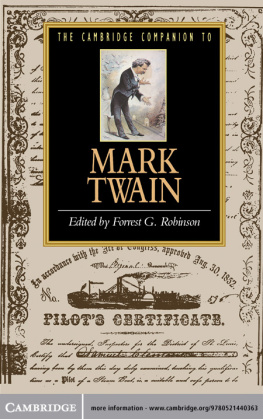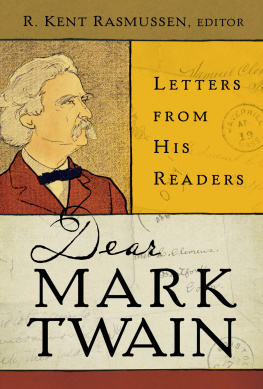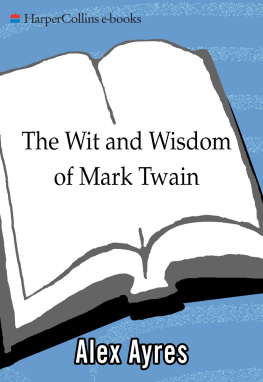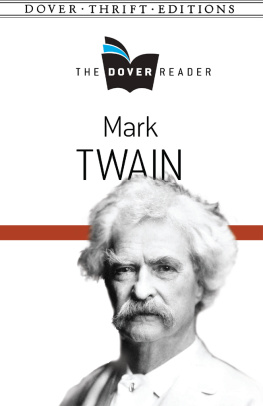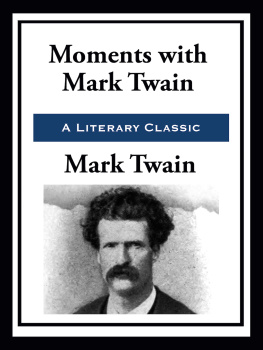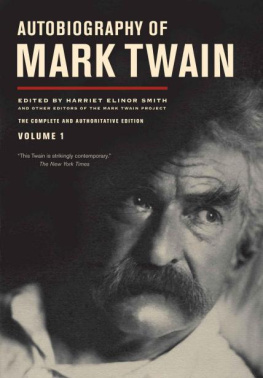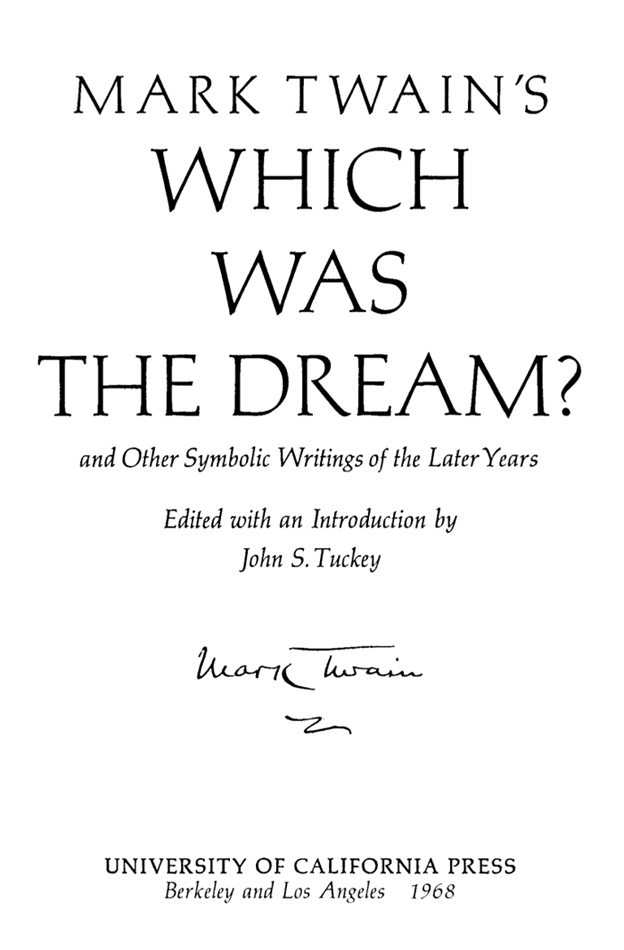Mark Twains
Which was the Dream?
And other Symbolic
Writings of the Later Years
John S. Tuckey,
Editor
UNIVERSITY OF CALIFORNIA PRESS
THE MARK TWAIN PAPERS
Editorial Board
WALTER BLAIR
DONALD CONEY
HENRY NASH SMITH
Associate Editor
FREDERICK ANDERSON

MARK TWAINS
WHICH
WAS
THE DREAM?
and Other Symbolic Writings of the Later Years
Edited with an Introduction by
John S. Tuckey

UNIVERSITY OF CALIFORNIA PRESS
Berkeley and Los Angeles 1968

U NIVERSITY OF C ALIFORNIA P RESS
Berkeley and Los Angeles, California
U NIVERSITY OF C ALIFORNIA P RESS , L TD .
London, England
1966 The Mark Twain Company
Library of Congress Catalog Number: 66-19100
ISBN: 0-520-01285-2
Designed by Adrian Wilson
Printed in the United States of America
Third Printing 1997
To Mother
Acknowledgments
Some Five years ago Henry Nash Smith gave me exceedingly valuable counsel and encouraged my following of a line of inquiry that led into a fascinating area of studythat of Mark Twains later writings. During my work in the Mark Twain Papers at the University of California, Berkeley, Frederick Anderson, the present literary editor of the Papers, has been extremely helpful in more ways than I could even begin to suggest without turning this section into a chapter. I am also greatly indebted to Albert Bigelow Paine, Mark Twains biographer and first literary editor, and to Bernard DeVoto, who pioneered in studying the unpublished later writingsespecially the Great Dark Manuscripts that appear in this volume. Valuable and much appreciated suggestions have been contributed by Paul Baender, Howard Baetzhold, Walter Blair, James M. Cox, Franklin R. Rogers, and Albert E. Stone, Jr. The works of a good many other scholars have also been used, in ways acknowledged in the notes; to them I here express my heartfelt thanks. The American Philosophical Society and the Purdue Research Foundation have provided generous and timely grants to make possible my working in the Papers. My wife Irene was a true helpmate in typing most of the manuscript for this book after being wonderfully gracious about my leaving her and Janis and Alan at home while I was at Berkeley. I am most grateful to all of the persons and organizations that have in so many ways helped me study and prepare for publication the manuscripts here presented. I am also deeply grateful to the Mark Twain Estate for permission to publish these materials.
J OHN S. T UCKEY
November 1965
Contents
Abbreviations
MTP | Mark Twain Papers, University of California, Berkeley |
LE | Letters from the Earth, ed. Bernard DeVoto (New York, 1962) |
LLMT | The Love Letters of Mark Twain, ed. Dixon Wecter (New York, 1949) |
MT & HF | Walter Blair, Mark Twain & Huck Finn (Berkeley, 1960) |
MTA | Mark Twains Autobiography, ed. Albert Bigelow Paine (New York, 1924) |
MTB | Albert Bigelow Paine, Mark Twain: A Biography (New York, 1923) |
MTE | Mark Twain in Eruption, ed. Bernard DeVoto (New York, 1940) |
MTHL | Mark Twain-Howells Letters, ed. Henry Nash Smith and William M. Gibson (Cambridge, 1960) |
MTL | Mark Twains Letters, ed. Albert Bigelow Paine (New York, 1923) |
MTN | Mark Twains Notebook, ed. Albert Bigelow Paine (New York, 1935) |
MTSatan | John S. Tuckey, Mark Twain and Little Satan (West Lafayette, Ind., 1963) |
Writings | The Writings of Mark Twain (New York, 1922-1925) 37 vols. |
Introduction
These selected later writings of Samuel L. ClemensMark Twainare here published for the first time, with but two exceptions: The Great Dark appeared in Letters from the Earth, as edited by Bernard DeVoto;
T HE B IOGRAPHICAL B ACKGROUND
All of the selections in this volume were composed between 1896 and 1905. Mark Twain wrote them after the disasters of the early and middle nineties that had included the decline into bankruptcy of his publishing business, the failure of a typesetting machine in which he had invested heavily, and the death of his daughter Susy. Their principal fable is that of a man who has been long favored by luck while pursuing a dream of success that has seemed about to turn into reality. Sudden reverses occur and he experiences a nightmarish time of failure. He clutches at what may be a saving
Prominent among the dream-like events of Mark Twains life were his experiences with the typesetter. He had first seen an early model in 1880 and had then met its gifted but eccentric inventor, James W. Paige. A few years later, after his imagination had become fired with the idea of developing and marketing the device, Paige offered him a substantial interest, and on 6 February 1886, he entered into a contract that he expected would make him one of the richest men in the world. The ship of fortune had become an abandoned wreck that would never make port.
Probably it was at about this time that he first planned the dream-of-disaster story. On 2 January 1895, he wrote a most revealing letter to Rogers:
Theres one thing which makes it difficult for me to soberly realize that my ten year dream is actually dissolved; and that is, that it reverses my horoscope. The proverb says, Born lucky, always lucky, and I am very superstitious. And so I have felt entirely certain that that machine would turn up trumps eventually. It disappointed me lots of times, but I couldnt shake off the confidence of a life-time in my luck.
Well, whatever I get out of the wreckage will be due to good luck the good luck of getting you into the schemefor, but for that, there wouldnt be any wreckage; it would be total loss.
I wish you had been in at the beginning. Then we should have had the good luck to step promptly ashore.
Miss Harrison has had a dream which promises me a large bank account, and I want her to go ahead and dream it twice more, so as to make the prediction sure to be fulfilled.
Ive got a first rate subject for a book. It kept me awake all night, and I began it and completed it in my mind. The minute I finish Joan I will take it up.
In the themes here touched uponthe man of great fortune whose luck deserts him, the dream extending over a period of years, the voyage of disasterthere are portents of much that is to be found in Mark Twains writings of the following period. In all probability the book planned at just this time was to contain such elements. And apparently it was this first rate subject for a book that he confided to William Dean Howells after returning to the United States in the next month, and that he later identified in a letter to Howells of 16 August 1898: in that letter he spoke of being again at work on a version of the story that he had mapped out in Paris three or four years ago and had thereafter told him about in New York under seal of confidence the story to be called


![Twain Mark - Autobiography of Mark Twain Vol. 1 / associate eds. Benjamin Griffin ... [et al.]](/uploads/posts/book/210276/thumbs/twain-mark-autobiography-of-mark-twain-vol-1.jpg)
